We may receive a commission when you use our affiliate links. However, this does not impact our recommendations.
For $250 and half an hour’s worth of simple improvements, you can cut precise mortises all day.
Mortising machines first answered the prayers of mortise-cutting woodworkers over 120 years ago. Today you can buy a miniaturized descendant of those old-timers. Though they’re not the only powered option you have for mortising these days, their square mortises are the perfect match for tablesawn tenons. We tested eight benchtop machines designed to cut mortises up to 1/2-in. wide. They’re similar in size and capacity, and all but one sell for less than $250. They all use the same specialized chisels and drill bits. The machines are easy to set up and ready to cut mortises within 20 minutes. After our own testing, we invited a group of professional and amateur woodworkers to try out the machines as well. All together, we cut hundreds of mortises with each machine, using 1/4-in. to 1/2-in. chisel sets, in mahogany, red oak and maple.
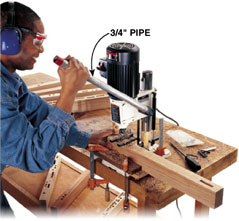

It’s Okay to buy Cheap Bits
For testing, each machine was outfitted with new chisel sets from the same manufacturer. We tried sets from British, American, Austrian and Japanese manufacturers before deciding to use the cheapest ones, which are made in Taiwan. You can spend a lot of money on chisel sets, but we think these inexpensive ones (usually less than $20), are a good buy. Out of the box, they needed the least amount of sharpening. They cut clean mortises and we found them easy to resharpen. Besides, accidents happen, bits get ruined and it’s less traumatic to replace a cheap set. Taiwanese sets are usually available from suppliers who sell benchtop mortisers.
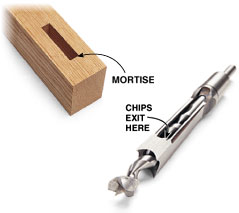
A HOLLOW CHISEL with an auger bit inside is the secret to machines that cut aquare mortises. First the auger roughs out the mortise by drilling a hole and clearing the chips. To square the corners, you have to force the chisel through the wood. This can take a lot of force-a square 1/2-in. mortise chisel has a 2-in. cutting edge. That’s why mortising machines take muscle to operate. |
The Major Difference Between Machines Is Motor Speed
Traditionally, mortisers used fast-speed, 3,450 rpm motors, but now slow-speed machines are also on the market. Three of the machines we tested have 1,725-rpm motors. Why the change? Manufacturers we talked to say slower speeds increase the life of the chisel sets. We think that’s one reason slow-speed machines are less stressful to use. You don’t have to worry about overheating the tooling. They’re also quieter and rarely cause smoke. However, they don’t cut mortises as easily as fast-speed machines. At a comfortable feed rate, we found cutting 1/2-in. mortises takes 5 to 10 foot/pounds more effort. Fast or slow speed? You have a choice between cutting ease and ease of mind.

Tune UP THE AUGER before you use it. With a small file, remove leftover machining burrs from the inside adge of it’s scoring spur and the angled top edge of its cutting lip. When these bits get dull they can wasil be re-sharpened. |
Ingredients for Successful Mortising
Mortisers aren’t foolproof machines. First of all, the chisel sets have to be installed correctly, with clearance between the chisel and auger. Tightening the auger securely in the chuck is critical. If the auger slips during a cut, it gets pressed up against the chisel and both can be ruined in an instant. Second, mortising requires technique, a combination of force and finesse. After all, the motor powers the auger bit, but it does nothing to square the round hole. Mortises are cut manually, using the hand lever to force the chisel through the workpiece. This can take a lot of effort. However, brute force isn’t everything. It’s important to match the chisel’s advance into the mortise with the cutting rate of the auger. A feed rate that’s too slow causes burning; one that’s too fast jams the chisel.
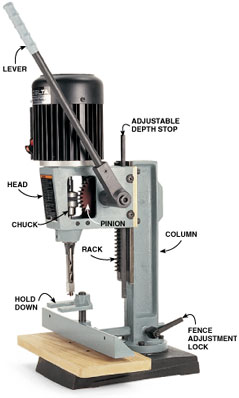
MOTISING MACHINES are lever-operated and require some arm strength to chop mortises. The lever, via a rack and pinion, controls the head’s movement up and down the column. A gas-filled shock holds th e head stationary in any position. The motor powers the auger bit, which extends through the hollow chisel. An adjustable fence positions the workpiece and a U-shaped hold-down keeps it in position. Mortises are made by advancing the workpiece along the fence while cutting successive squared holes. |
Hold-Downs: The Achilles’ Heel of Mortise of Mortisers
Our tests revealed an unfortunate similarity between machines: The hold-down systems don’t work, especially when large chisel sets are used. It’s hard to withdraw the chisel after cutting a single four-sided mortise, especially in a hard wood like maple. If the hold-down allows the workpiece to twist, the chisel gets wedged in the mortise and is impossible to get out. Easy withdrawal requires a level of accurate machining and rigidity the hold-down systems on these mortisers don’t possess. The Multico machine is the only one that separates the hold-down from the adjustable fence, which is a good idea. Instead, it mounts independently on the column. Unfortunately, this hold-down fails just as often because of its lock-down device, which is a real pain to tighten. A chain is only as strong as its weakest link. The inadequate hold-downs are frustrating because, for the most part, these machines are well built. Fortunately, we found simple solutions that eliminated the problems.
Hold Do you prefer smoking or non-smoking? Motor speed is an important consideration when you choose a mortiser.
 SMOKING AND BURNING are normal, according to the owner’s manuals of fast-speed mortisers. These machines are hard on chisel sets because they generate a lot of heat while mortising. When they get too hot, the chisel and auger turn blue and lose their temper (inset). Slow-speed machines are much less likely to ruin chisel sets. Fast-speed machines are noisy and nerve-wracking to operate, but they cut mortises with less effort than slow-speed versions. SMOKING AND BURNING are normal, according to the owner’s manuals of fast-speed mortisers. These machines are hard on chisel sets because they generate a lot of heat while mortising. When they get too hot, the chisel and auger turn blue and lose their temper (inset). Slow-speed machines are much less likely to ruin chisel sets. Fast-speed machines are noisy and nerve-wracking to operate, but they cut mortises with less effort than slow-speed versions. |
 A LONGER HANDLE makes mortising easier. The extra leverage gained by slipping a 20-in. length of pipe over the hand lever helps most when cutting 1/2-in. mortises with slow-speed machines because they require more effort than their fast-speed counterparts. Slow-speed machines are also more likely to stall while cutting, so high motor amperage (min. 5 amps.) is important, especially when you lengthen the handle. A LONGER HANDLE makes mortising easier. The extra leverage gained by slipping a 20-in. length of pipe over the hand lever helps most when cutting 1/2-in. mortises with slow-speed machines because they require more effort than their fast-speed counterparts. Slow-speed machines are also more likely to stall while cutting, so high motor amperage (min. 5 amps.) is important, especially when you lengthen the handle. |
At less than $250, benchtop mortisers are a bargin. Even so, you can spend a lot less for machine mortising, or you can spend a lot more.
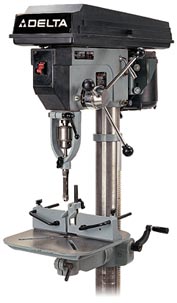 CONSIDER AN ATTACHMENT for your drill press. It’s inexpensive (less than $40) and works well enough if you only need to mortise occasionally. However, your drill press wasn’t designed for mortising. The head isn’t rigid enough and the short handles don’t give you much leverage. In hard use the tables flex considerably. CONSIDER AN ATTACHMENT for your drill press. It’s inexpensive (less than $40) and works well enough if you only need to mortise occasionally. However, your drill press wasn’t designed for mortising. The head isn’t rigid enough and the short handles don’t give you much leverage. In hard use the tables flex considerably. |

INDUSTRIAL-QUALITY mortising machines have large capacity and adjustable tables. Instead of cheaply made hold-downs held by a setscrew, they use a massive plate, threaded like a vise, to wedge the workpiece firmly in place. Although it costs $650, our testers loved this Powermatic model #719, which weighs in at 188 lbs. |

At first glance, the machines appear quite different. But we found that few of the differences directly affect performance. It doesn’t matter whether the fence is cast iron or angle steel. What matters is that the fence is square to the table. Two machines came with fences that weren’t square and needed replacing. It doesn’t matter how the head is mounted to the column. What matters is whether the head can be adjusted so it can move up and down the column without racking. Only one machine lacks this adjustability. It doesn’t matter whether the hold-down device is fastened to a post on the fence or mounted directly to the column. What matters is that it does its job. At best, the hold-downs on these machines are barely adequate. It doesn’t even matter which motor speed you choose. Although we liked working with slow-speed machines better, fast-speed machines cut mortises just as well.
 USE TWO SCRAPS OF WOOD when you install the chisel and bit. One acts as a spacer between the chisel and its bushing to assure proper clearance between the auger and the hollow chisel. Its thickness depends on the size of the chisel. Check the owner’s manual. The other scrap protects your finger while you hold the auger in position for tightening. Tighten the chuck in all three holes so the auger won’t come loose during a cut. Then remove the spacer and snug up the chisel against the bushing. Square it to the fence (inset) and tighten the setscrew. USE TWO SCRAPS OF WOOD when you install the chisel and bit. One acts as a spacer between the chisel and its bushing to assure proper clearance between the auger and the hollow chisel. Its thickness depends on the size of the chisel. Check the owner’s manual. The other scrap protects your finger while you hold the auger in position for tightening. Tighten the chuck in all three holes so the auger won’t come loose during a cut. Then remove the spacer and snug up the chisel against the bushing. Square it to the fence (inset) and tighten the setscrew.
|
Remember three things when you install chisel sets:
|
The hold-down systems on these machines stink!
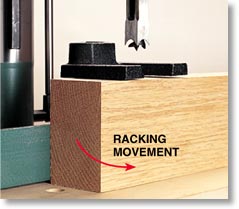
THIS HOLD-DOWN doesn’t sit flat, so the workpiece it’s supposed to hold is free to twist, or “rack,” underneath it. Poor-fitting hold-downs are common and they’re the weak link in these machines. |
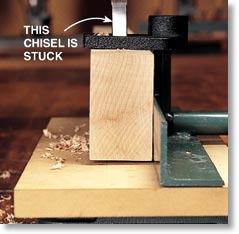 A POOR-FITTING HOLD-DOWN caused the chisel to bind in this mortise because it allowed the workpiece to rack. Once a chisel is stuck, it’s a real pain to get loose. Some of our testers were so frustrated by hold-down failures they decided they wouldn’t buy any benchtop mortiser. A POOR-FITTING HOLD-DOWN caused the chisel to bind in this mortise because it allowed the workpiece to rack. Once a chisel is stuck, it’s a real pain to get loose. Some of our testers were so frustrated by hold-down failures they decided they wouldn’t buy any benchtop mortiser. |
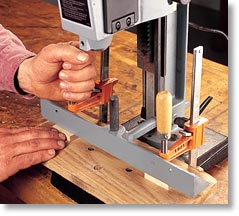
CLAMP THE FENCE to the mortiser’s table, using spacers if necessary, so it stays put when the chisel is withdrawn. |
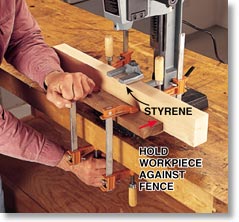 CLAMP A BOARD in front of the workpiece so it can’t rack. Sand or file the bottom of the hold-down so it sits flat. Then use cyanoacrylate (CA) glue to attach a piece of styrene to its bottom. (Both CA glue and sheets of styrene are available at hobby stores.) Styrene helps the workpiece slide back and forth more easily under the hold-down. CLAMP A BOARD in front of the workpiece so it can’t rack. Sand or file the bottom of the hold-down so it sits flat. Then use cyanoacrylate (CA) glue to attach a piece of styrene to its bottom. (Both CA glue and sheets of styrene are available at hobby stores.) Styrene helps the workpiece slide back and forth more easily under the hold-down. |

The hold-downs on these machines are a disappointment. The problems were so obvious and our fixes were so simple, it’s puzzling that no manufacturer has bothered to come up with a better system. At the very least, the manufacturers should include a section in their owner’s manuals titled something like “Getting the Most Out of Your Mortiser” that would show how to make these improvements. We bet most woodworkers would be willing to pay more for a machine that they didn’t have to mess with. Because none of the machines was able to consistently cut 1/2-in. mortises without additional clamps and fences, we’ve decided not to give an Editors’ Choice award. We’ll wait for a basic machine with a hold-down system that’s effective through the range of its capacity.
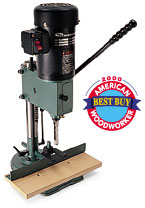
|

|
Best Buys
With improvements to their hold-down systems, six of the machines we tested consistently cut mortises effectively. Five of these mortisers are competitively priced and received our Best Buy award. The sixth, the Multico PM 12, costs $300 more. The Delta and Jet machines run at 1,725 rpm. Mortisers from Bridgewood, Grizzly and Woodtek, which have similar castings and are virtually identical, have fast-speed motors. These machines are a definite improvement over mortising on the drill press. There are better ones on the market, but they cost a lot more. At less than $250, all five of these mortisers are a bargain, and are winners of our Best Buy award.
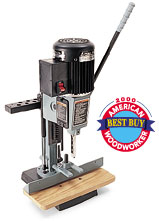
|

|
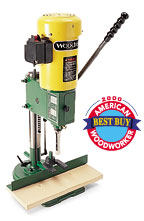
|
|
![]()
| Model | Street Price Excluding Shipping |
Chisel Sets Included |
1/2 HP Motor Amperage | Motor Speed (rpm) | Fence Square to Table |
Chuck Access | Comments | Supplier |
| Bridgewood HM-11 | $219 | None | 6A @ 110V | 3,400 | Yes | Right hand only | Good performance. Powerful motor. Adjustments require two Allen wrenches (supplied) and a screwdriver (not supplied). Machines from Bridgewood, Grizzly and Woodtek have similar castings. | Wilke Machinery Co. (800) 235-2100 |
| Central Machinery 35570 | $150 | 1/4-in., 3/8-in. and 1/2-in. | 2.3A @ 110V | 3,580 | No | Both hands | Underpowered, but will cut small mortises, Fit between head and column is not adjustable. Head racks under load. Fence adjustment very limited. Spring loaded return on hand lever is potentially dangerous. | Harbor Freight Tools, Inc. (800) 423-2567 |
| Craftsman 351.219060 | $200 | None | 4A @ 120V | 1,725 | No | Both hands | Comes with tool caddy for bits and wrenches. 4-amp motor stalls under load. Fence doesn’t work well because its mounting post is offset from the chisel. | Sears, Roebuck, and Co. (800) 377-7414 |
| Delta 14-650 Type 2 | $242 | 1/4-in., 5/16-in., 3/8-in., 1/2-in. | 5A @ 120V | 1,725 | Yes | Both hands | Solid performance. One easy-to-use T-handle Allen wrench tightens everything but the chuck. Comes with tool caddy for bits and wrenches. Spring-loaded chuck key is a pain to use. | Delta Intl. Machinery Corp. (800) 438-2486 |
| Grizzly G3183 | $225 | None | 6A @ 110V | 3,400 | Yes | Right hand only | Good performance. Powerful motor. Adjustments require two Allen wrenches (supplied) and a screwdriver (not supplied). Machines from Bridgewood, Grizzly and Woodtek have similar castings. | Grizzly Industrial, Inc. (800) 523-4777 |
| Jet JBM-5 | $239 | 1/4-in., 3/8-in., 1/2-in. | 6A @ 115V | 1,720 | Yes | Both hands | Highest amperage slow-speed motor. Spring-hinged doors allow easiest access to chuck. Best chuck key of the group – large, with long shaft and T-handle Thumbscrew on hold-down is hard to tighten. | Jet Equipment and Tools, Inc. (800) 274-6848 |
| Multico PM 12 | $549 | 1/2-in. | 5.1A @ 110V | 3,470 | Yes | Both hands | Well-built machine, but costly. Column mounted hold-down is effective, but difficult to tighten. One easy-to-use T-handle Allen wrench tightens everything but the chuck. Supplied 13/16″ chisel bushing won’t work with inexpensive chisel sets. Manual needs improvement. | Garret Wade, Inc. (800) 221-2942 |
| Woodtek 876-775 | $240 | None | 6A @ 110V | 3,450 | Yes | Right hand only | Good performance. Powerful motor. Adjustments require two Allen wrenches (supplied) and a screwdriver (not supplied). Machines from Bridgewood, Grizzly and Woodtek have similar castings. | Woodworker’s Supply (800) 645-9292 |
Here are some supplies and tools we find essential in our everyday work around the shop. We may receive a commission from sales referred by our links; however, we have carefully selected these products for their usefulness and quality.







